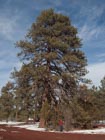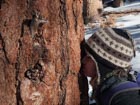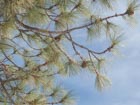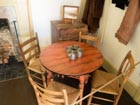Pinus brachyptera
Engelmann 1848
Common names
Southwestern ponderosa pine.
Taxonomic notes
Although it was described in 1848, for most of historic time, this species has been regarded as a variety or subspecies of Pinus ponderosa. However, recent molecular analyses have clearly shown that P. ponderosa is paraphyletic if so treated, thus P. brachyptera is resurrected to describe a group of "ponderosa" pines distinguishable by morphology and molecular markers. See the "Taxonomic notes" for P. scopulorum for a detailed discussion.
Syn: P. ponderosa Dougl. ex Laws. var. brachyptera (Engelm.) Lemmon 1888, P. ponderosa Dougl. ex Laws. subsp. brachyptera (Engelm.) Callaham 2013. Engelmann was a bit vague about the type locality; Callaham (2013) places it in New Mexico at approximately (35.667, -105.467). This species forms natural hybrids with Pinus arizonica in Arizona, New Mexico, and south just into Sonora in Mexico (Kral 1993).
P. brachyptera is largely disjunct from P. ponderosa. The two species' distributions nearly touch in southern California, but for many other plants in that area, the desert north of the Transverse Ranges marks a biogeographic boundary, and I have treated it so here. Near the southern range limits of the species, however, the picture becomes more complex. In the far south of Arizona, P. brachyptera reaches its range limits, and its ecological role is met by Pinus arizonica, a closely related taxon distributed primarily in Mexico. One haplotype is predominant in Arizona and New Mexico (analysis by Potter et al. 2013 and by Willyard et al. 2021b), but as it is the most widespread haplotype in the Ponderosae, that isn't very illuminating. There is also a haplotype that occurs in southern California and southern Nevada, and (disjunct) in southeast New Mexico (Potter et al. 2013). The cause of this disjunction is not known, but may represent a consequence of northward dispersal from a former Mexican refugium during climatic warming and drying since the last glacial maximum.
Description
Monoecious evergreen trees to 24 (-50) m tall and 100 (-164) cm DBH; crown broadly conic to rounded. Stem usually straight and robust; branches thick and persistent; usually one whorl per year; usually 3 to 6 branches in a whorl, the branches inserted at a 48° angle from apex of the stem of young trees. Bark on mature trees vertically fissured, dark brown or dark gray to black; on old trees becoming reddish brown to cinnamon brown, thick, with broad plates separated by shallow fissures. Xylem oleoresin odor (discernible in bark crevices warmed by the sun) usually smells like turpentine. Needles finely serrate, acute, finely lined with stomata on all faces, 11-20 cm long × 1.4-2 mm thick, slightly twisted, green to blue-green, paler and shorter at higher elevations and under xeric conditions; generally not glaucous, but becoming glaucous at higher elevations and with the onset of winter; moderately pliable, and in fascicles of 3; remaining green on stem an average of 2.5-5.9 years, longer at higher elevations; persisting on branch only a few years, giving a tufted appearance to branches; enclosed at the base by sheaths of papery bracts that are, in the first year, 10-15% of needle length but that weather away to leave a thick, dark brown to black sheath 4-8 mm long. Vegetative shoots elongating only once each year; in the current year, reddish-brown with blue or purple waxy bloom. Vegetative buds covered with ovate acute scales that are conspicuously fringed with fairly short, brownish hairlike projections; scales closely appressed, light chestnut-brown or gray brown, dotted with resin during summer, sometimes covered with resin during winter. Pollen cones borne in clusters of 5-30, ellipsoid-cylindric, 15-35 mm long, yellow. Seed cones solitary or rarely in pairs, in first year 15-25 mm long, on stalks half as long; red on emergence, turning greenish brown, with short, appressed, mucronate scales, prickles usually erect; symmetrical and straight to slightly curved, averaging 75 mm long, truncate-ovoid; color during second summer green, maturing to tan and darker brown; subsessile and deciduous during the first winter after ripening, very short stalk and a few basal scales usually persisting temporarily on branch after the cone falls. Seed cone scales narrow, slightly concave, usually rounded at apex; apophysis yellow to brown, lustrous, only slightly elevated along a transverse keel; umbo salient and forming base of a stout, persistent prickle usually directed outward, but occasionally slightly reflexed; adaxial surface slightly concave and dull tawny to red brown; abaxial surface dark brown, purplish, or blackish. Seeds dark brown or speckled; ovoid acute; 5-7 mm long with a width-length form factor of about 2/3. Seed wings thin, semitransparent, pale brown, sometimes darkly streaked with brown; widest at or slightly below midpoint; gradually narrowed to rounded apex; 3.3-4.3 times as long as the seed; average length 15.5 mm (Callaham 2013, Kral 1993).
See P. ponderosa for a table detailing differences from the other taxa commonly called "ponderosa pine".
Distribution and Ecology
USA: Arizona, Colorado, Nevada, New Mexico, and Utah; Mexico: N Sonora. Mostly at 1000-3000 m elevation (Kral 1993).
Molecular studies (summarized by Willyard et al. 2021a, 2021b) indicate a fairly extensive area where P. brachyptera and P. scopulorum co-occur. In general, herbarium specimens assign collections to these taxa with indifferent accuracy, and so there is currently low confidence regarding the range limits of each species within the area that, in general, includes eastern Nevada, all of Utah, and southwestern Colorado. It is likely that some hybridization occurs as well, although its extent is not well understood.
Distribution data. Colored polygons showing species distribution from USGS (1999). P. ponderosa subsp. ponderosa is shown in red, P. ponderosa subsp. benthamiana in green, and P. brachyptera and P. scopulorum in blue. Boundaries between subspecies are in many cases gradational, and trees in boundary areas may show intermediate characters. Point data represent my personal observations and published herbarium data. My observations are dated, precisely located, and include a listing of associated tree species ranked in descending order of dominance. Published herbarium data are extracted from the GBIF database and are of variable reliability.
This species presents one of the best examples of the superb adaptation to wildfire that characterizes much of the genus Pinus. Studies in the Gila Wilderness area of Arizona and New Mexico have found that due to frequent summer lightning storms and the accumulation of pine needles on the forest floor, low intensity surface fires may travel through pine stands with an average frequency of once every three years. These frequent burns discourage competitive species such as scrub oak and shade tolerant conifers. Mature pines are not harmed by such fires due to their thick, fire resistant bark, while their seedlings also have an excellent chance of surviving low-intensity burns, because their rootstocks often survive (Swetnam and Dieterich 1985). In the historical period, an enthusiastic program of fire suppression has virtually eliminated these small, frequent fires. As a consequence, shrubs and shade-tolerant conifers have invaded many yellow pine stands while thick accumulations of highly combustible fuels have built up on the forest floor. Now, when a fire does occur, it is likely to be extremely destructive, destroying vast stands of prime forest. Since the mid-1970s, some forest managers have attempted to reintroduce low intensity fire to this ecosystem, but their efforts are often thwarted both by a "Smokey the Bear" mentality ingrained in the public mind, and by the high cost of monitoring prescribed fire in an ecosystem that has accumulated high fuel loads (ironically, there always seems to be plenty of funding to fight the catastrophic fires that result from the absence of fuels control burns).
The same problem can also be viewed from a historical perspective. Early travelers in the West often commented on the vast, parklike stands of pine that they encountered. There are tales of stands of giant trees separated by grassy swards, with no other understory vegetation. Many of these stands were so open and level that a carriage could easily be driven through them, and some writers report stands of this character so extensive that they took days to ride across.
The IUCN does not recognize this as a species distinct from P. ponderosa and P. scopulorum and their conservation assessment for P. ponderosa conflates the three taxa. However, it is probable that P. brachyptera would rank as "Least Concern" under IUCN criteria due to its extensive area of occupancy and the limited scope of its threats.
Remarkable Specimens
The largest known tree has diameter 164 cm, height 41.5 m, and grows in Lee Canyon in the Spring Mountains of southern Nevada (Robert Van Pelt e-mail 2004.02.04; note that this might be a specimen of P. scopulorum). The tallest tree is in the Dutch Creek drainage, San Juan Mountains, Colorado, and stood 49.5 m tall with a dbh of 83 cm when discovered and measured on 2014.08.03 (Markworth 2014; note that this also might be a specimen of P. scopulorum). Another very tall tree, also in the San Juans, was measured by Bob Leverett in 2009 at 48.98 m tall and 86.6 cm dbh (Robert Van Pelt e-mail 2009.06.22; again, might be a specimen of P. scopulorum). Another very large/tall tree is about 20 miles southeast of Pagosa Springs, Colorado: 43.9 m tall and 145 cm DBH in 2003 (Robert Van Pelt e-mail 2007.10.23; also might be a specimen of P. scopulorum). In general, I suspect that these trees are good P. brachyptera, as it seems to generally occupy better sites and achieve larger sizes than P. scopulorum.
The oldest tree known was identified from a core collected in the Wah Wah Mountains of Utah by S. Kitchen; it had a crossdated age of 929 years (RMTRR 2006). This is also a crossdated age of 843 years for specimen BRY4002, collected in central UT by Schulman in 1956 (Brown 1996). There is also an old but credible record of a ring count of 1,047 from a tree in southwestern Colorado (Mills 1914). Note that all of these trees are within the range shared by P. brachyptera and P. scopulorum and are perhaps representatives of P. scopulorum.
Ethnobotany
Within its range, this is an economically important timber species. Common current uses include structural lumber, lumber for furniture and finish carpentry, firewood, and log cabin construction. Under the name "ponderosa pine", it is "generally recognized as the most versatile wood found in abundance in North America" (Western Wood Products Association 2018).
Historically, the cambium would be scraped for food (often only in times of famine) by the Apache, Chiricahua, Mescalero, Navajo, and Paiute tribes. Nearly everyone ate the seeds, usually roasted, sometimes ground into a flour. The pitch or sap was used by many tribes including the Paiute for a wide variety of purposes including as a salve or ointment for sores, boils, cuts and earache; to reduce inflammation of the eyes; to treat backache or rheumatism; and to pacify babies by spreading it on their skin. Decoctions of green leaves were put to similar uses. Many tribes used the pitch as a glue or sealer. The wood was widely used in structures, to make dugout canoes, and for other uses such as cradle boards, ladders, and of course firewood (University of Michigan Ethnobotany Database 2013.09.07).
P. brachyptera has been the subject of hundreds of studies in dendrochronology, and indeed the invention of the science of dendrochronology by astronomer Andrew Ellicott Douglass began with his inspection of ponderosa pine stumps near Flagstaff, Arizona. He went on to devise a graphical way of plotting year-to-year variation in ring widths from those stumps, initially in an effort to find evidence of long-term variations in solar output, and subsequently developed an early analog computer to further study this idea. Although his efforts to find solar cycles in tree rings were largely unsuccessful, his techniques also served to develop the use of tree-ring methods to date wood used by prehistoric peoples throughout the American southwest, and this very successful dating technique led to the proliferation of dendrochronology as a science.
Observations
In my experience, exceptionally old and picturesque trees may be found on the plateaus of northern Arizona and New Mexico, where ponderosa (likely a mixture of P. brachyptera and P. scopulorum) provided the forests that were used in building the Anasazi civilization 900 years ago. Fine trees are also common in the Sky Island ranges of southern Arizona, particularly the Santa Catalinas, the Chiricahuas and the Pinalenos.
Remarks
This species is a principal host for the dwarf mistletoe Arceuthobium vaginatum subsp. cryptopodum (Hawksworth and Wiens 1996).
"On July 4, 1876, Arizona lumberjacks stripped branches from the tallest ponderosa they could find, and hoisted the American flag in celebration of the nation's centennial-that's how the town of Flagstaff got its name" (Wood Magazine 2018).
Quail, squirrels and many other kinds of wildlife consume the seeds, and nutcrackers and chipmunks cache them, thereby helping to bring forth new pines (Little 1980).
Citations
Callaham, Robert Z. 2013. Pinus ponderosa: A taxonomic review with five subspecies in the United States. Research Paper PSW-RP-264. Albany, CA: USDA Forest Service Pacific Southwest Research Station. 52p.
Engelmann, G. 1848. Sketch of the botany of Dr. Wislizenus' expedition. Appendix to Wislizenus, F.A., Memoir of a tour to northern Mexico, pp. 87-115. Available at the Biodiversity Heritage Library.
Engelmann, G. 1880. Revision of the genus Pinus, and a description of Pinus elliottii. Trans. St. Louis Acad. Sci. 4:161-190. Available at the Biodiversity Heritage Library.
Lascoux, M., A.E. Palme, R. Cheddadi, and R.G. Latta. 2004. Impact of Ice Ages on the genetic structure of trees and shrubs. Philosophical Transactions of the Royal Society of London. B, Biological Sciences 359:197-207.
Lawson, P. 1836. Agriculturist's Manual. Edinburgh (p. 354).
Markworth, Matt. 2014.08.14. Hermosa Creek - Tall Rocky Mountain Ponderosa Pine. www.ents-bbs.org/viewtopic.php?f=70&t=6495&sid=8af5a9126e89fa3e988e8a2ecabd370b#p29581, accessed 2014.08.17.
Mills, Enos A. 1914. The story of a thousand year pine. Houghton Mifflin Co. Boston, MA. The story can be found online (bless those copyright expiration laws!) HERE.
Murray, E. 1982. Notae Spermatophytae No. 1. Unum minutum monographum generis Pinus. Kalmia 12:18-27.
Potter, K.M., V.D. Hipkins, M.F. Mahalovich, and R.E. Means. 2013. Mitochondrial DNA haplotype distribution patterns in Pinus ponderosa (Pinaceae): range-wide evolutionary history and implications for conservation. American Journal of Botany 100(8):1-18.
Silba, J. 2009. Journal of the International Conifer Preservation Society 16(1): 30.
Swetnam, T. W., and J. H. Dieterich. 1985. Fire history of ponderosa pine forests in the Gila Wilderness, New Mexico. Pages 390-397 in J. E. Lotan, B. M. Kilgore, and R. W. Mutch, technical coordinators. Proceedings of the symposium and workshop on wilderness fires, 15-18 November 1983, Missoula, Montana. General Technical Report INT-182. United States Forest Service, Ogden, Utah, USA. Available: Internet Archive, accessed 2021.11.27.
Western Wood Products Association. 2018. Ponderosa pine. www.wwpa.org/western-lumber/species/ponderosa-pine, accessed 2018.10.03.
Willyard, Ann, David S. Gernandt, Blake Cooper, Connor Douglas, Kristen Finch, Hassan Karemera, Erik Lindberg, Stephen K. Langer, Julia Lefler, Paula Marquardt, Dakota L. Pouncey, and Frank Telewski. 2021. Phylogenomics in the hard pines (Pinus subsection Ponderosae; Pinaceae) confirms paraphyly in Pinus ponderosa, and places Pinus jeffreyi with the California big cone pines. Systematic Botany 46:538–561.
Wood Magazine. 2018. Ponderosa pine. www.woodmagazine.com/materials-guide/lumber/wood-species-3/ponderosa-pine, accessed 2018.10.03.
M.P. Frankis contributed much to the development of this page in 1998.12.
See also
Allen, Craig D. 1995. A Ponderosa Pine Natural Area Reveals Its Secrets. In Status and Trends of the Nation's Biological Resources. USGS electronic publication. http://biology.usgs.gov/s+t/SNT/noframe/sw153.htm, accessed 2002.09.03.
Burns & Honkala 1990.
Douglass, Andrew Ellicott. 1919. Climatic Cycles and Tree Growth. Washington, DC: Carnegie Institute of Washington. 127 pp.
Elwes and Henry 1906-1913 at the Biodiversity Heritage Library. This series of volumes, privately printed, provides some of the most engaging descriptions of conifers ever published. Although they only treat species cultivated in the U.K. and Ireland, and the taxonomy is a bit dated, still these accounts are thorough, treating such topics as species description, range, varieties, exceptionally old or tall specimens, remarkable trees, and cultivation. Despite being over a century old, they are generally accurate, and are illustrated with some remarkable photographs and lithographs.
Fiedler, Carl. E. and Stephen F. Arno. 2015. Ponderosa: People, Fire, and the West's Most Iconic Tree. Mountain Press Publishing Company, 260 pages.
Lanner 1983.
Murphy, Alexandra. 1994. Graced by Pines: The Ponderosa Pine in the American West. Mountain Press Publishing Company, 119 pages.
FEIS database.






